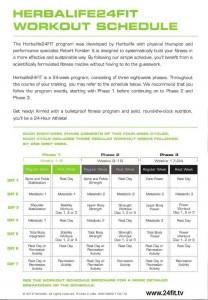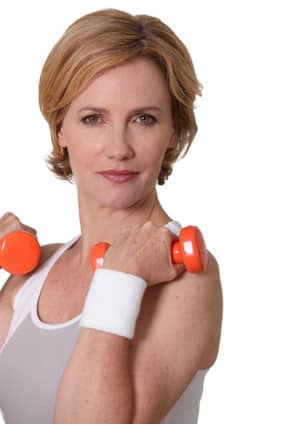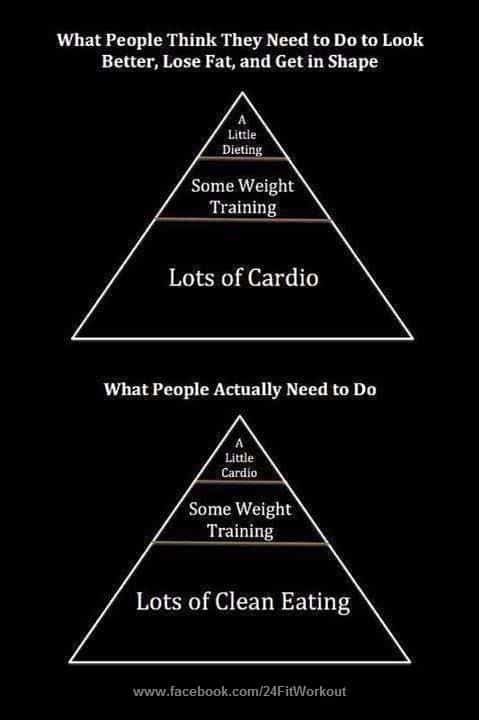by 24fit | Oct 8, 2013 | Injury Prevention, Periodization Training, Strength Training
 If you want to keep jumping into every fad fitness workout that comes along and don’t care about losing large chunks of time (and your hard earned fitness) to nagging injuries and burnout, then keep following the fads. But if you want to get lean and fit and stay fit, stop getting injured, and maybe train for a specific event, your run-of-the-mill haphazard training won’t cut it. To kick your fitness up several notches and keep it there year round, you have to train in a way that is good for your body, building it up methodically while limiting the potential for disruptive injuries.
If you want to keep jumping into every fad fitness workout that comes along and don’t care about losing large chunks of time (and your hard earned fitness) to nagging injuries and burnout, then keep following the fads. But if you want to get lean and fit and stay fit, stop getting injured, and maybe train for a specific event, your run-of-the-mill haphazard training won’t cut it. To kick your fitness up several notches and keep it there year round, you have to train in a way that is good for your body, building it up methodically while limiting the potential for disruptive injuries.
To do that, you need a strategy that is almost bipolar in that it combines workouts that progress your fitness with rest days and rest weeks. Over the weeks and months, this hard/easy training schedule is the paradigm that gives your body time to recover and get stronger, more flexible and leaner.
Sequence is key. The science shows that you have to properly sequence your training to develop one aspect of fitness at a time and then use that as a foundation to build the next. In fact, to achieve your best fitness levels you must be incredibly patient. You will spend a long time building a broad base of aerobic infrastructure and musculoskeletal resiliency before adding more intense workouts. This strategy is virtually foolproof, used by the world’s best athletes in every sport, and it’ll work for you if you have the discipline to follow it.
It’s called Periodization.
The foundation of all modern sports training, Periodization was developed in the Eastern Bloc countries during the cold war in an attempt to dominate the world of sport. It proved so effective that now athletes all over the world, and across all sports, use it routinely to achieve the highest levels of fitness while avoiding burnout and injury. The reason this approach to fitness is so effective and has replaced of all other approaches is because it is on based research showing how the body best responds to exercise. It’s all about human adaptation and it provides predictable outcomes when exercise is orchestrated in a scientifically rational sequence.
Basically, the Periodization model builds your fitness up with a stair step series of methodical, progressive challenges and recoveries that strengthen your body and keep brain and brawn fresh.
Check out the 13 DVDs used in the 24 Fit Workout, which incorporate Periodization Training methods.
by 24fit | Sep 10, 2013 | Body Composition, Fat Burning, Over 35s, Strength Training
Many people put on weight as they get older – but it doesn’t have to happen. Let’s talk about why weight tends to creep up with age, and what can you do about it.
I can’t tell you how many times I’ve had a patient say to me, “everybody gains a little weight as they get older!” To them, picking up a few extra pounds every year is just something to be expected. And, they figure, if “everyone is doing it” – it must be okay. But truth is, middle-aged weight gain doesn’t happen to everyone. Yes, some adults put on weight fairly steadily in their middle years – to the tune of about a pound a year, on average. But just because creeping weight gain does happen to a lot of people, doesn’t mean that it has to.
Why do we tend to put on weight as we age?
It may seem that weight gain as you get older is inevitable – but it’s not. That’s not to say you don’t need to pay attention though – you’ve still got plenty of things working against you that can make weight management more challenging with each passing decade.
For one thing, there’s often a downward shift in the number of calories you spend when you exercise. As you get older, you may tend to move a bit less, or to exercise less vigorously – all of which adds up to fewer calories burned over the course of the day. If you’re exercising less than you used to – but still eating the way you did in your 20’s – you shouldn’t be surprised if you’re packing on the pounds.
Then there are changes in body composition that are a natural part of the aging process. You tend to lose muscle as you age – partly because your muscle cells just don’t repair themselves the way they used to. When you’re younger, the everyday wear and tear of your muscles gets patched up relatively quickly, but over time, the process slows down – which means you can lose some muscle mass. Natural dips in hormone production – estrogen, testosterone and growth hormone levels all decline with age – can also contribute to some loss of muscle mass.
Since muscle tissue does a lot of metabolic ‘work’ that uses up a lot of calories, the loss of muscle tissue as you age means that you will burn fewer calories per day than you used to – in other words, your metabolic rate slows down.
This subtle shift in your metabolism starts somewhere in your 20s or 30s. You start to slowly lose muscle tissue and gradually pick up some body fat. By the time women reach the age of about 40 and men enter their 60’s, they start to lose about 6-8% of their muscle mass every ten years. That translates into a drop in metabolic rate of about 10% every decade.
Diet clearly plays a role here, too. If the rate at which you burn calories is slowing down, then you need to apply the brakes to your calorie intake, too, if you want to avoid weight gain. In many cases, people are taking in too many calories simply because they are eating they way they did 20 years ago, but moving a lot less. But the other thing that sometimes happens as people get older is that their eating habits change – and not always in a good way. “Empty nesters” who are no longer cooking for a family might stop preparing full, healthy meals. Instead, they might snack more, or rely more on higher calorie convenience foods or fast foods. Some people simply eat more meals out because it’s easier – but calorie control is often sacrificed. And, as people get older and find themselves less busy, eating can also become a calorie-laden form of entertainment.
 6 tips for controlling your weight as you age
6 tips for controlling your weight as you age
- Don’t assume that weight gain is inevitable. With that attitude, you’ll be a lot less likely to take the necessary steps to keep your weight in check. Gaining weight in your middle years doesn’t ‘have to’ happen – and if it already has, it isn’t too late to get it under control.
- Strength train a few times a week. Strength training is one of the best things you can do to retain – and even build – muscle. Since muscle cells burn calories at a much faster rate than fat cells do, building up your muscle mass will boost your metabolic rate. And don’t think you’re too old – studies show that with the proper resistance exercise, even people in their 80s can experience increases in muscle size and strength.
- Keep up with the cardio and you could keep weight gain in check. Any exercise that gets your heart pumping is going to burn calories, so aim for at least 30 minutes of cardiovascular exercise most days of the week. If the pace at which you walk or jog has slowed over time, keep in mind that you’ll also be burning fewer calories than you used to. To compensate, you’ll need to cut your calorie intake a bit or – if you can – exercise for a little longer. If you haven’t exercised in a while, be sure to get clearance from your doctor before you start out.
- Fill up on low calorie, high-volume foods. Vegetables and whole fruits are “nutrient-dense” – which means they offer up a lot of nutrition for a relatively small calorie cost. Vegetables and whole fruits not only provide a lot of nutrients, they contain plenty of water and fiber, so they help to fill you up – not out.
- Eat protein at each meal or snack. Protein not only helps your body to build and repair muscle mass, it also helps control hunger. The trick is to opt for the leanest sources, so that you get your protein without a lot of added fat that can often tag along. Choose seafood, poultry breast, egg whites, low fat or nonfat dairy products, lean cuts of red meat, and plant proteins such as tofu, beans, lentils, and protein powders which can be made into smoothies.
- Keep a diary. A daily journal can help you to stay motivated. Keep tabs on your weight and write down what you eat, how much exercise you do and how much water you drink every day. That way, you’ll be able to track the results and rewards of your efforts.
Written by Susan Bowerman, MS, RD, CSSD. Susan is a paid consultant for Herbalife. Herbalife markets protein-based meal replacements, powders, and snacks.
by 24fit | Aug 23, 2013 | Exercise Intensity, Fat Burning, Nutrition
By using the right nutrition and exercise working together to get results.
” To look your best focus on reducing your body fat.” “The key to losing body fat is to encourage your body to gain more lean muscle.” Samantha Clayton, PT, Former Competitive Sprinter and Track Coach.
Many people don’t get adequate protein in their diet, or of they do it comes with extra calories. Protein is essential in gaining lean muscle together with exercise. Increase your lean muscle you will burn more calories.
Exercise at an intensity level of 6 or 7 out of 10 will prompt your body to burn fat as a fuel source, which is why the metabolic workouts of Phase 1 of the 24 Fit program start with low intensive exercises. Then there is a progression in intensity, through Phase 2 and 3. This way you teach your body to burn fat.
On alternate days complete the strength training workouts to help build and tone the muscles.
More info on the 24 Fit DVDs
by 24fit | Aug 20, 2013 | Cardiovascular, Fat Burning, Fitness DVDs, Over 35s, Strength Training
Training for a half marathon but cant lose weight? Cycling several times per week, but carrying excess weight?
The calories you burn during workouts are inconsequential to your overall body weight or body fat content! Instead, it is how well you use your exercise time to reprogram your daily physiology that matters.
“Many people say that, as they age, they eat and exercise the same amount but still gain weight. One of the main causes of this is loss of muscle mass. Genetically, women have less muscle than men, and as a woman ages, the preservation of lean muscle becomes vital. By the time you’ve hit 30, muscular strength begins to head south. But the majority of the decrease occurs after age 50, when it falls at the rate of 15 percent per decade. “Tom Holland, Exercise Physiologist
“By Your mid-30s, most people still look young, but are already experiencing the BIG Three of aging: deteriorating lean muscle mass, worsening posture, and crumbling joints” say Robert Forster, Physical Therapist, PT and developer of the 24 Fit Workout.
Have you experienced a Monday morning bloat after a weekend of great workouts? Ever look in the mirror and see a pudgy, bloated you and the scale says you’ve gained a pound or two for all your hard efforts?
The “Fit But Fat” Syndrome is attributable to poor daily nutrition and improper training schedules. Common problems:
- Poor daily nutrition habits
- Working harder and harder, not smarter
- Too many intense workouts creating a metabolism dependent on carbohydrates not fats
- Calorie restriction causing your metabolism to idle
- Ill advised training programs dictated by whim and not science
Solutions:

Chow Down and Eat Clean
Eating too little will force your body into “starvation mode,” which will cause it to store added fat for energy (out of fear of not being fed) rather than burning fat and keeping your belly taut. To lose weight you need to consume fewer calories than you expend. However, if you don’t maintain good levels of macro and micro nutrients, you may find you are never satisfied after eating, or still lack energy, making you reach for products such as sugary drinks, biscuits or other unhealthy snacks. These foods can cause an energy spike (rise in blood sugar) followed by an energy crash (fall in blood sugar), which leads to further fatigue and hunger. Skipping meals, especially breakfast may seem like a good way to cut calories, but it can leave you feeling tired and hungry long before your next meal. Take two Herbalife shakes and one balanced meal containing lean protein to lose fat.
Strength Training
“Adding strength training to your workout routine builds muscle and helps you burn more calories during and after your workout”, says Tom Holland, author of Beat the Gym. In fact, researchers found that women who did strength training increased their resting metabolic rate (the calories your body needs to get through the day) for as long as 16 hours post-exercise.
Start with Low Intensive Exercise
Longer, low intensity aerobic exercise forces your body to burn fats better and improves the way your body processes sugar as well. For athletes and the general public, aerobic activities reprogram your body to use fat as its preferential fuel and will enable us to work harder for longer periods of time with less fatigue. Robert Forster teaches via the 24 Fit Workout Programme how to become a more efficient calorie-burning machine, so you are going to burn fat all day – whether you are at work, at play or even whilst you sleep. 24Fit gradually increases in intensity so you dont workout harder you workout smarter.
Keep Cardio in Check
“Muscle is more metabolically active than fat, which means the more you have, the faster your metabolism is and the more calories you burn all day long—all key for a whittled middle. Resistance training builds this quality lean muscle, so do two to three total-body strength sessions a week”, says Tom Holland, exercise physiologist. “For fat-melting cardio, all you need to do is your weight, he adds: If you’re 145 pounds, do 145 minutes a week, broken up however fits into your schedule—say, 60 minutes Saturday, 45 Tuesday, and 40 Thursday”
How to transform your body into a fat burning machine
 If you want to keep jumping into every fad fitness workout that comes along and don’t care about losing large chunks of time (and your hard earned fitness) to nagging injuries and burnout, then keep following the fads. But if you want to get lean and fit and stay fit, stop getting injured, and maybe train for a specific event, your run-of-the-mill haphazard training won’t cut it. To kick your fitness up several notches and keep it there year round, you have to train in a way that is good for your body, building it up methodically while limiting the potential for disruptive injuries.
If you want to keep jumping into every fad fitness workout that comes along and don’t care about losing large chunks of time (and your hard earned fitness) to nagging injuries and burnout, then keep following the fads. But if you want to get lean and fit and stay fit, stop getting injured, and maybe train for a specific event, your run-of-the-mill haphazard training won’t cut it. To kick your fitness up several notches and keep it there year round, you have to train in a way that is good for your body, building it up methodically while limiting the potential for disruptive injuries.

